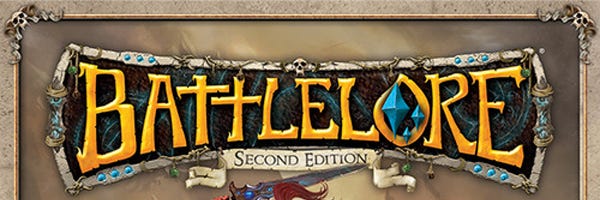Cardboard Children - Battlelore 2nd Edition
This game system
Hello youse.
As we build up to my historic announcement of the best board game of 2013, I think it's worth taking a break to talk about an exciting new edition of a great game. I'm really pumped about how good this game is. Are you sitting down? Do you like dice? Do you like games with lots of replayability?
Okay then.
BATTLELORE 2ND EDITION
Oh shit, son.
This game system, this Richard Borg game system, this Command and Colors game system, this game system.
This game system.
When I got back into board games in a big way, many years ago now, Memoir 44 was one of the first games I picked up. It operated under Mr Borg's incredible Command and Colors game system, and it was fantastic. In the years that followed, I picked up Command and Colors itself, and many other games that used the same basic ruleset. Games like Battles of Westeros and Abaddon and Battlelore. I loved them all.
Here's a basic explanation of how the game system works. You have a board representing a battle map, laid out with hexagons. That board is split into three sections. Left flank, right flank, centre. You have units on your side of the board, and you draw cards from a deck. Those cards allow you to command your troops. A card might say “ORDER TWO UNITS ON THE LEFT”. Or it might say “ORDER ONE UNIT FROM EACH SECTION”. Then you move your troops and roll some dice to attack. The game system is, at its core, about managing your hand of command cards to get the best out of your troops. Essentially, this system only lets you command some of your troops some of the time, so you better get thinking about what you're going to do next.
(The different versions of the game introduced different elements. Abaddon is more chaotic, with you rolling command dice to activate your robots. Battles of Westeros ties commands to the influence area of generals in your army.)
Battlelore introduced something else – Lore cards. Lore cards were cards with magical effects, or power boosts, or – look, put simply, Lore cards were “cool shit” cards. It was a great game.
But then – THEN.... A whole mess happened. Days of Wonder sold Battlelore to Fantasy Flight and then Fantasy Flight said it was too expensive to produce so no more printings came to light and then they introduced Battles of Westeros as a Battlore game and I have no idea why they did that and everyone got really angry because everyone really wanted more Battlelore and it looked like Battlelore was dead and the original edition got really expensive on the second hand market and everyone was pretty much totally pissed off at this point it was really horrible and I don't like it when people fight.
But the dark days are over. Battlelore 2nd Edition is out. And it's pretty much a slam dunk. And I don't even know anything about baseball!
Okay, so those old game mechanics? Left flank, right flank, centre? Present and correct. Two armies in beautiful plastic. One red, one blue. Archers, dudes on horses, big monsters. Lots of tiles representing hills and forests and rivers and villages. A deck of command cards and a deck of lore cards for each army. All. Present. And. Correct.
Here's something cool – when you are about to play a game, each player selects a scenario card that covers their side of the board. When two players put those cards together, it shows the full map, and how to set it up, and what special conditions are in play. This means you never really know what kind of battle you'll be fighting until that stuff is revealed. It adds a lot of variety. There's a “fog of war” mechanic too. When you set up your units at the start of the game, you'll also place decoy units on the board. Your true placements are hidden. All of this stuff gives a real sense of drama to the start of a battle, and helps stop stuff sliding into predictability.
Battlelore, like all the Command and Colors games, is easy to learn and play. I think it flows so smoothly because you can only think about a few things at any one time. Because you are limited in your commands from moment to moment, it feels like you are zooming into different areas of battle. “I will think about this now” and then “I will deal with this now”. It's always tense, but never overwhelming. There's dice-chucking, sure, and every game under this game system will throw up a few moments of being horribly unlucky with the dice. But your opponent will have those moments too, and it's your job to try to lessen the impact of your freak events.
The units are brilliant. There are these crazy barbarian fellas who get stronger the more hurt they get. So, if you attack them, you better hope you wipe them out. Otherwise, you've just pissed them off. There are archers with poisonous arrows. There's a big giant bird thing with a guy riding on it. There's flavour dripping everywhere. The two armies in the box, and those modular scenario cards you lock together, ensure you can play this thing forever.
But wait. There's something else.
This just recently popped up on the Fantasy Flight site -
So, what do we have here? A brilliant edition of a brilliant version of one of the most brilliant game systems ever devised. A massive amount of variety in the box, and now a scenario builder that just kicks the whole thing open.
I'm sure I don't have to say anything else. This shit is tried and tested. The safest of safe bets. Buy it.










